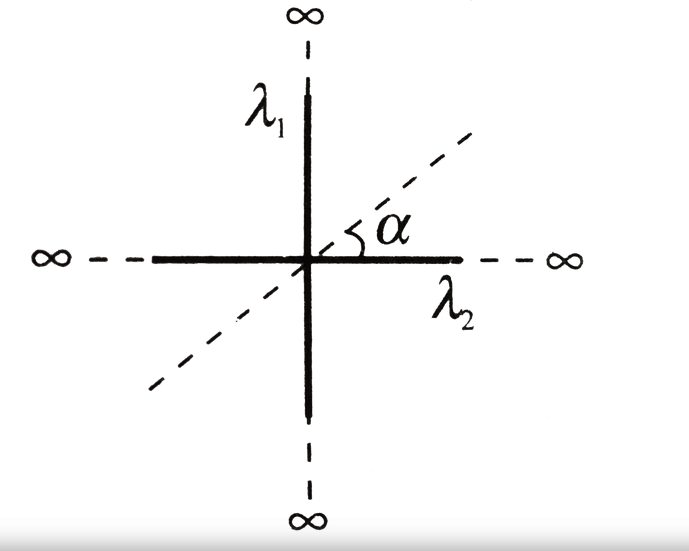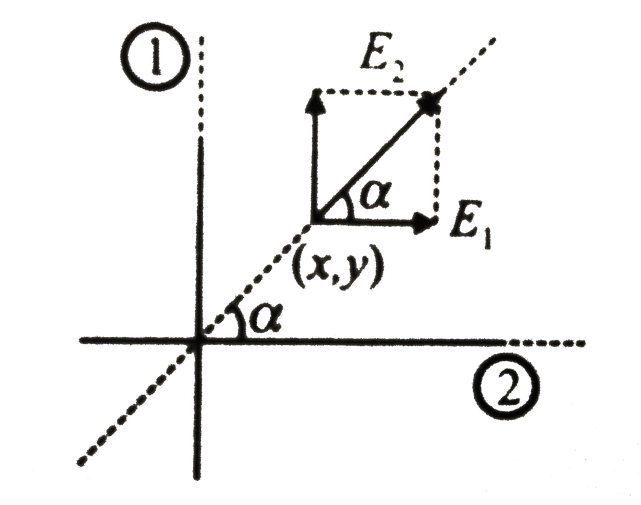
Two mutually perpendicular wires carry charge densities $\lambda_{4}$ and $\lambda_{2}$. The electric line of force makes angle a with the second wire then finds $\lambda_{4} / \lambda_{2}$.
(in terms of angle $a$ ).

A) $\cot ^{2} \alpha$
B) $\cot \alpha $
C) $\tan ^{2} \alpha$
D) $\tan \alpha $
Answer
141k+ views
Hint: We know that the external electric field is a fundamental requirement for electrospinning and an important factor governing the fibre diameter. Melt-electrospinning involves the stretching of predominantly non conducting liquid under the influence of an applied electric field. On Earth, flowing of liquid metal in the outer core of the planet generates electric currents. The rotation of Earth on its axis causes these electric currents to form a magnetic field which extends around the planet. The magnetic field is extremely important to sustaining life on Earth.
Complete step by step answer
We know that the electric field is defined as the electric force per unit charge. The direction of the field is taken to be the direction of the force it would exert on a positive test charge. The electric field is radially outward from a positive charge and radially in toward a negative point charge.
The space around an electric charge in which its influence can be felt is known as the electric field. The electric field Intensity at a point is the force experienced by a unit positive charge placed at that point. Electric Field Intensity is a vector quantity.
Electric fields (e-fields) are an important tool in understanding how electricity begins and continues to flow. Electric fields describe the pulling or pushing force in a space between charges. The electric fields of single charges. A negative charge has an inward electric field because it attracts positive charges.

$E_{1}=\dfrac{\lambda_{1}}{2 \pi \varepsilon_{0} x}$ and ${{E}_{1}}=\dfrac{{{\lambda }_{q}}}{2\pi {{\varepsilon }_{0}}y}$
$\dfrac{E_{1}}{E_{2}}=\left(\dfrac{\lambda_{1}}{\lambda_{2}}\right)\left(\dfrac{y}{x}\right)$
$\dfrac{1}{\tan \alpha}=\left(\dfrac{\lambda_{1}}{\lambda_{2}}\right) \tan \alpha$ or $\dfrac{\lambda_{1}}{\lambda_{2}}=\cot ^{2} \alpha$
So, the correct answer is option A.
Note: We can say that the electric field lines flow from positive to negative charges. Such sources are well suited for surface applications such as wound healing, corneal repair or even brain and spinal stimulation with closely-separated, inserted electrodes. Electric field is not negative. It is a vector and thus has negative and positive directions. An electron being negatively charged experiences a force against the direction of the field. For a positive charge, the force is along the field. A measure of the strength of an electric field at a given point in space, equal to the force the field would induce on a unit electric charge at that point.
Complete step by step answer
We know that the electric field is defined as the electric force per unit charge. The direction of the field is taken to be the direction of the force it would exert on a positive test charge. The electric field is radially outward from a positive charge and radially in toward a negative point charge.
The space around an electric charge in which its influence can be felt is known as the electric field. The electric field Intensity at a point is the force experienced by a unit positive charge placed at that point. Electric Field Intensity is a vector quantity.
Electric fields (e-fields) are an important tool in understanding how electricity begins and continues to flow. Electric fields describe the pulling or pushing force in a space between charges. The electric fields of single charges. A negative charge has an inward electric field because it attracts positive charges.

$E_{1}=\dfrac{\lambda_{1}}{2 \pi \varepsilon_{0} x}$ and ${{E}_{1}}=\dfrac{{{\lambda }_{q}}}{2\pi {{\varepsilon }_{0}}y}$
$\dfrac{E_{1}}{E_{2}}=\left(\dfrac{\lambda_{1}}{\lambda_{2}}\right)\left(\dfrac{y}{x}\right)$
$\dfrac{1}{\tan \alpha}=\left(\dfrac{\lambda_{1}}{\lambda_{2}}\right) \tan \alpha$ or $\dfrac{\lambda_{1}}{\lambda_{2}}=\cot ^{2} \alpha$
So, the correct answer is option A.
Note: We can say that the electric field lines flow from positive to negative charges. Such sources are well suited for surface applications such as wound healing, corneal repair or even brain and spinal stimulation with closely-separated, inserted electrodes. Electric field is not negative. It is a vector and thus has negative and positive directions. An electron being negatively charged experiences a force against the direction of the field. For a positive charge, the force is along the field. A measure of the strength of an electric field at a given point in space, equal to the force the field would induce on a unit electric charge at that point.
Recently Updated Pages
Young's Double Slit Experiment Step by Step Derivation

Difference Between Circuit Switching and Packet Switching

Difference Between Mass and Weight

JEE Main Participating Colleges 2024 - A Complete List of Top Colleges

JEE Main Maths Paper Pattern 2025 – Marking, Sections & Tips

Sign up for JEE Main 2025 Live Classes - Vedantu

Trending doubts
JEE Main 2025 Session 2: Application Form (Out), Exam Dates (Released), Eligibility, & More

JEE Main 2025: Derivation of Equation of Trajectory in Physics

A point charge + 20mu C is at a distance 6cm directly class 12 physics JEE_Main

JEE Main Exam Marking Scheme: Detailed Breakdown of Marks and Negative Marking

Learn About Angle Of Deviation In Prism: JEE Main Physics 2025

Electric Field Due to Uniformly Charged Ring for JEE Main 2025 - Formula and Derivation

Other Pages
JEE Advanced Marks vs Ranks 2025: Understanding Category-wise Qualifying Marks and Previous Year Cut-offs

Electric field due to uniformly charged sphere class 12 physics JEE_Main

JEE Main 2025: Conversion of Galvanometer Into Ammeter And Voltmeter in Physics

Degree of Dissociation and Its Formula With Solved Example for JEE

Dual Nature of Radiation and Matter Class 12 Notes: CBSE Physics Chapter 11

Formula for number of images formed by two plane mirrors class 12 physics JEE_Main




